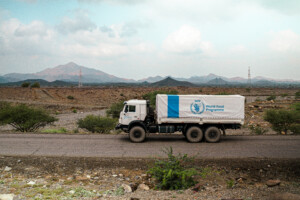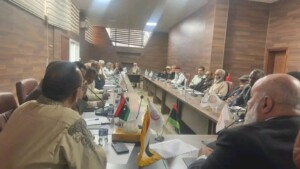Sudan OCHA bulletin 23: About 1,000 new displaced in West Darfur need assistance
On 29 May, humanitarian partners, in collaboration with the Humanitarian Aid Commission (HAC) in West Darfur carried out a needs assessment of an estimated 1,00 displaced villagers in Habila. These people arrived in the town during the last week of May following inter-communal tension in the area. The inter-agency team identified food and non-food household supplies as the main needs of the new displaced, the UN Office for the Coordination of Humanitarian Affairs (OCHA) reports in its latest weekly bulletin.
On 29 May, humanitarian partners, in collaboration with the Humanitarian Aid Commission (HAC) in West Darfur carried out a needs assessment of an estimated 1,00 displaced villagers in Habila. These people arrived in the town during the last week of May following inter-communal tension in the area. The inter-agency team identified food and non-food household supplies as the main needs of the new displaced, the UN Office for the Coordination of Humanitarian Affairs (OCHA) reports in its latest weekly bulletin.
Meanwhile, some residents have reportedly been leaving Azerni village in Kereinik locality, about 30 km east of the state capital El Geneina, following an attack by unidentified armed men on a mosque in the village on 22 May. Though the security situation in the village remained calm during the past week, residents are reportedly leaving the area for fear of reprisals. The government authorities and traditional leaders from both communities are engaged in negotiations to resolve the problem and tensions.
About 1,220 people were newly displaced in West Darfur throughout 2015, OCHA reports. This was the lowest displacement figure among Darfur states during 2015.
According to the Strengthening the Rule of Law and Legal Protection in Darfur project of the UN Development Programme (UNDP), “the causes of the conflict in Darfur are multiple and complex, but weak governance, coupled with competition over increasingly limited natural resources (land, water, and livestock) essential for survival, underpin much of it. The spread of small arms has fuelled a situation where weaponry and violence often now define relationships between groups and communities”.
Jebel Marra crisis
Humanitarian organisations continue to assess the needs of people affected by the Jebel Marra crisis, those who sought shelter in North, South, and Central Darur, and returnees, and provide them with assistance and basic services.
On 31 May, an inter-agency mission carried out a rapid needs assessment of an estimated 7,000 people in the Kass camp for the displaced in South Darfur. They arrived at the camp in April after fighting erupted between Sudanese government forces and the Sudan Liberation Movement led by Abdelwahid El Nur (SLM-AW) in parts of the Jebel Marra region.
In North Darfur, humanitarian response continues for an estimated 59,700 displaced people who fled Jebel Marra to four locations in North Darfur: 22,600 in Sortony, 31,000 in Tawilla, 2,909 in Kabkabiya town and 3,182 in Shadad camp in Shangil Tobaya. In Sortony, the World Food Programme (WFP) has distributed two months rations of emergency food assistance to 22,600 people. In Tawila, the Sudanese Red Crescent Society (SRCS) and local community leaders carried out in May a re-registration of new arrivals in Tawila from Jebel Marra, which resulted in an increase in the total number of new displaced from 31,000 to 43,419 individuals who received 398 MT as a one-month food ration for May.
The number of Jebel Marra displaced in Central Darfur reported by the government’s Humanitarian Aid Commission (HAC) has increased and currently stands at about 58,000 people. With the addition of some 4,500 IDPs in Hasahisa and Hamidiya camps in Zalingei, the overall number is estimated to be 62,600 people.
The magnitude of displacement remains unknown due to access restrictions for international humanitarian partners to verify the numbers of the displaced and assess the humanitarian situation in most places.
More than 70,000 arrivals from South Sudan
During the first five months of 2016, more than 70,000 South Sudanese arrived in Sudan as a result of conflict and deteriorating food security conditions in their home country. East Darfur is hosting the majority of the refugees, close to 47,000 people (See also the OCHA/UNHCR Fact sheet of 11 June). The flow of South Sudanese refugees into White Nile State also continues, with about 9,000 arrivals into the existing sites since the beginning of 2016.
Major gaps in funding the response for the South Sudanese influx into Sudan, especially in South Darfur, are affecting the ability of humanitarian organisations to provide assistance and basic services. Inter-agency requirements for the South Sudanese situation response in Sudan amount to $141.2 million, of which only 13 percent had been received as of 26 May. A proposal for a Central Emergency Response Fund (CERF) rapid response allocation of $8 million was submitted on 1 June. The CERF funding will be used to respond to the priority needs of new arrivals in East Darfur, including establishment of a new site near the Khor Omer camp, near the capital Ed Daein, to host the refugees.
As of 5 June, the Sudan Humanitarian Fund (SHF) Reserve for Emergencies has allocated $1.8 million in response to pressing WASH and emergency shelter/non-food items needs of South Sudanese who have been arriving in Khor Omer. The SHF Reserve for Emergencies aims to fund projects that address recent unforeseen significant humanitarian needs through life-saving activities for which a critical funding gap exists.
A response plan for the new influx has been developed by humanitarian partners and UNHCR, outlining priority response measures and financial requirements up to the end of June 2016. The plan covers response activities in East and South Darfur, West Kordofan and White Nile and amounts to a total of $49 million, of which $29.5 million is needed for East Darfur.
Conflict in South Kordofan passes five-year mark
5 June 2016 marks five years since the conflict between government forces and the Sudan People’s Liberation Movement-North (SPLM-N) started in South Kordofan. The conflict has resulted in significant civilian displacement, affected the lives and livelihoods of thousands of people, and had a major impact on access to education for many children. The UN has been calling upon the Government of Sudan and SPLM-N to cease hostilities, engage in direct and constructive talks without conditions, and make the necessary concessions to reach agreement on ending the conflict in South Kordofan and Blue Nile states, in accordance with provisions of UN Security Council Resolution 2046 (2012).











 and then
and then